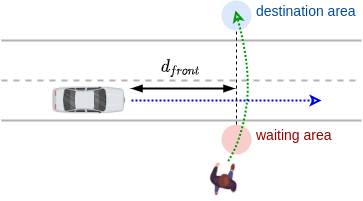This is the official repository for the following submission in IV2020: A Multi-State Social Force Based Framework for Vehicle-Pedestrian Interaction in Uncontrolled Pedestrian Crossing Scenarios.
Affiliations:
- Control and Intelligent Transportation Research (CITR) Lab
- Department of Electrical and Computer Engineering
- Center for Automotive Research (CAR)
Update Log:
- 2020-05-15: Released with the final submission of IV2020.
The framework focuses on uncontrolled pedestrian crossing scenarios:
Below is the structure of the vehicle-pedestrian interaction framework:
Video demostration of two different vehicle control strategies:
- Model predctive control (MPC)
- Obstacle avoidance control (OAC)
Environment Configuration:
python3.6+is required.- To generate the animation, you system must install
FFmpeg. If you haven't done so, please go to https://ffmpeg.org/, download and installFFmpegin your operating system. - You need to install the packages specified in
requirements.txtfile. You can either usepip install -r requirements.txtto automatically install all the required packages or install them manually one by one.
Running the program:
simulate.py: run this script to start a simulation.- Before running, in
if __name__ == '__main__':section, change the configuration:- Control Method: you can select from different vehicle control method by specifying
control_methodvariable.mpcis model predictive control,oacis obstacle avoidance control, andvkcis velocity keep control. (Details of control strategy see the associated paper.)
- Control Method: you can select from different vehicle control method by specifying
- Initial Vehicle State: change the
init_statevariable. The first component is the longitudinal position, the second component is the longitudinal velocity (which is also the desired speed). - This simulation result will be stored as a
.pfile inresultsfolder.
- Before running, in
evaluate.py: run this script to start evaluation.- Before running, you need to change the global variable
data_pathto point to the pickle.pfile generated bysimulate.pyscript. - After evaluation, you will find the results in the
resultsfolder.
- Before running, you need to change the global variable
Feel free to create an issue or shot me an email: Dongfang Yang (yang.3455@osu.edu)



